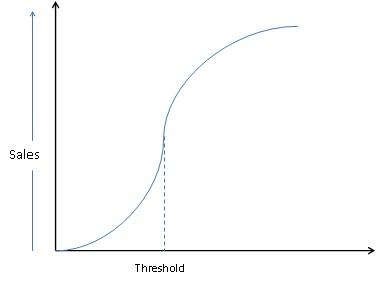- Business Concepts ›
- Marketing and Strategy ›
- Threshold Effect
Threshold Effect
Definition & Meaning
This article covers meaning & overview of Threshold Effect from marketing perspective.
What is meant by Threshold Effect?
Threshold effect is the cumulative effect of repeated advertising over a period of time when the effect of the advertisement is found in the form of customer recognition which is seen through an increase in sales. This phenomenon is observed when sales surpass a certain quantitative limit which is called the threshold; hence the name threshold effect.
The expenditure incurred by a company till this point is considered as an approximate for estimating further advertising budgets. Threshold effect is the point when the customer recognition or awareness of a particular brand or product is recognised or increased. A company’s aim would be to reduce this threshold i.e. to reduce the cost and the time period before which the customer starts recognising the brand or product. One has to careful about the threshold effect while marketing or advertising about any product or brand. Sometimes it so happens that the threshold is never reached and the customer fails to recognise the brand. If a little more money was spent in print or other media for advertising about the product, the threshold effect can be overcome, resulting in awareness about the brand in the customers’ minds. Unless awareness is attained, a company cannot expect to sell its products because this is the first stage in any customer purchasing model, like AIDA (Awareness – Interest – Desire – Action). The graph for threshold effect looks like the figure shown below:

As shown in the graph, the sales increase after the threshold.
Hence, this concludes the definition of Threshold Effect along with its overview.
This article has been researched & authored by the Business Concepts Team which comprises of MBA students, management professionals, and industry experts. It has been reviewed & published by the MBA Skool Team. The content on MBA Skool has been created for educational & academic purpose only.
Browse the definition and meaning of more similar terms. The Management Dictionary covers over 1800 business concepts from 5 categories.
Continue Reading:
What is MBA Skool?About Us
MBA Skool is a Knowledge Resource for Management Students, Aspirants & Professionals.
Business Courses
Quizzes & Skills
Quizzes test your expertise in business and Skill tests evaluate your management traits
Related Content
All Business Sections
Write for Us